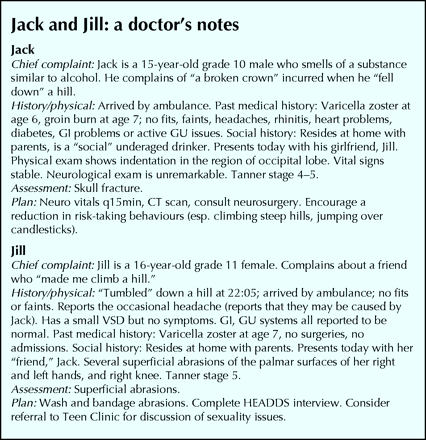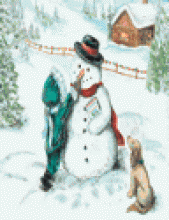Although nursery rhymes are considered an integral part of childhood, the medical events experienced by their characters have never been documented. Several popular nursery rhymes portray head injuries as inevitable events that do not require medical follow-up. In this paper, we document the prevalence of head injuries in nursery rhymes and discuss the appropriateness of the responses to them.

Figure.

Figure. Photo by: Alan King
Methods
We performed a rigorous search of MEDLINE using the terms “nursery rhyme*” and “head injur*,” with no results. We then searched google.ca using the term “nursery rhyme.” Using the first 5 sites listed, we compiled an index of nursery rhymes and then searched each one for references to potential head injuries.
Results
We found 6 rhymes in which head injury was mentioned or suggested: “Humpty Dumpty,” “Jack and Jill,” “Hush-a-bye-baby,” “Ten Little Monkeys,” “It's Raining, It's Pouring” and “Ring Around the Rosie.” No single category appears to have been spared injury. Babies, teenagers, old men, primates, nongendered, nondescript characters — everyone suffered.
Interpretation
Studying these nursery rhymes raised several pertinent issues: the appropriateness of the response to injury, the importance of seeking a medical opinion, the need for clarity about the events precipitating the injury, and the need to use precise medical terminology.
In the case of Humpty Dumpty, we question whether “all the king's horses and all the king's men” were capable of launching an appropriate medical intervention after Mr. Dumpty's unfortunate accident. What sort of EMS training and equipment did these first responders have? Although the accompanying saddlebags might have contained a cervical collar, it is unlikely that a spinal board would have been available, seriously compromising spinal management. The presence of “all the king's men” also suggests a shocking lack of crowd control. Could the crowded scene explain the inability of the responders to “put Humpty together again”? Should this attempt even have been made, given the circumstances? Might a “snatch and run” by real EMS personnel have saved the victim?
The infant in “Hush-a-bye-baby” must have sustained great trauma after falling to the ground “when the bough broke,” but medical attention does not seem to have been sought. If it was, it was not documented. But why was this infant in the tree in the first place? Child Protective Services should have been called to interrogate the child's guardian, who was obviously failing to provide a safe environment. Sadly, there is no reference to any complaint being filed against the child's caregiver, nor of any effort to treat the unfortunate child.
There are obvious parallels between events described in “Hush-a-bye-baby” and “Ten Little Monkeys.” The latter begins with 10 monkeys jumping on a bed. By its end, none is jumping. Why? Might each monkey have acquired a significant head or spinal injury while jumping on the bed, and therefore been left unable able to perform this activity? Although Mama did the right thing by calling “the doctor,” it is clear that no examination of the injured monkeys was conducted. Indeed, the doctor's only advice, which was presumably offered over the phone, was that there should be “no more monkeys jumping on the bed.” The CMPA has consistently warned against dispensing this type of medical advice over the phone. The physician the mother consulted in this case would have been wise to follow that advice and to have visited the house in question — perhaps 9 tragedies could have been avoided. This rhyme is yet another example of the need for strong legislation to protect members of our society who are at risk. After the first incident, the monkeys should have been placed in foster care, perhaps with The Man with the Yellow Hat.
“Jack and Jill” offers a unique glimpse into an incident involving adolescent victims, but the description of their injuries leaves much to be desired. It is difficult to ascertain the extent of Jack's injury. Does a broken “crown” refer to a skull fracture? The use of this inexact term reminds readers that colloquial expressions can detract from a patient's future care and that appropriate medical terminology should be used whenever possible. And the injuries that Jill sustained when she “came tumbling after” Jack are not documented. Is this yet another case of medical discourse excluding women?
The case of the “old man” who “went to bed and bumped his head and couldn't get up in the morning” that is documented in “It's Raining, It's Pouring” is worthy of CSI. There are 2 versions. The first version is presented above, but the second one changes the sequence of events so that the old man “bumped his head” then “went to bed.” Obviously, establishing the exact sequence of events is crucial to the creation of a differential diagnosis. If the elderly gentleman bumped his head after retiring for the evening, one is forced to entertain potential foul play, seizure activity or even a postcoital MI (there is no evidence to confirm the commonly held belief that he was alone). Also, it should be noted that he was “snoring.” Could his death have been precipitated by severe obstructive sleep apnea? If he actually bumped his head before going to sleep, the list of potential mechanisms is endless, and a good forensic investigation is required to determine the cause of death. The notoriously poor documentation of factors precipitating head injury in nursery rhymes makes it impossible to determine what really happened in this case as well as others.
“Ring Around the Rosie” supposedly tells the tale of young children living during the infamous Black Plague. Depending on the version, the words “Ashes, ashes” or “Ahusha, ahusha” precede “They all fall down.” It is absurd to think that a pneumonic process could take an entire group of children from the joyous noise of a game to the silence of death this quickly. Clearly, something happened that led to physical — and probably cranial — disaster. We hypothesize that an earthquake or faulty decking caused the children to experience head trauma simultaneously, and this explains why the poem ends so abruptly. Again, the lack of a clear history and the use of colloquial terms make it impossible to determine what actually happened.
Conclusion
Nursery rhymes are often recited to children, but little thought is given to their content. Our study shows that not only do many nursery rhymes detail incidents that could have resulted in severe head injury, but also that a medical opinion is seldom sought. (We do not consider the alternative care practitioners we cited — all the king's horses and all the king's men — to be true medical personnel.)
In an attempt to change this sad situation, we have written a new nursery rhyme that provides a realistic and medically accurate account of what actually happens when a head injury is sustained.
A Medically Sound Nursery Rhyme
Little Johnny rode his bike,
No helmet on his head.
He took a fall and split his skull,
His mother feared him dead.
She rushed him to the ER,
Where they checked his neuro signs.
They noted a blown pupil
And inserted IV lines.
They called the neurosurgeon,
Who came in and drilled a burr.
Now Johnny's fine; he rides his bike,
But he's helmeted, for sure.











